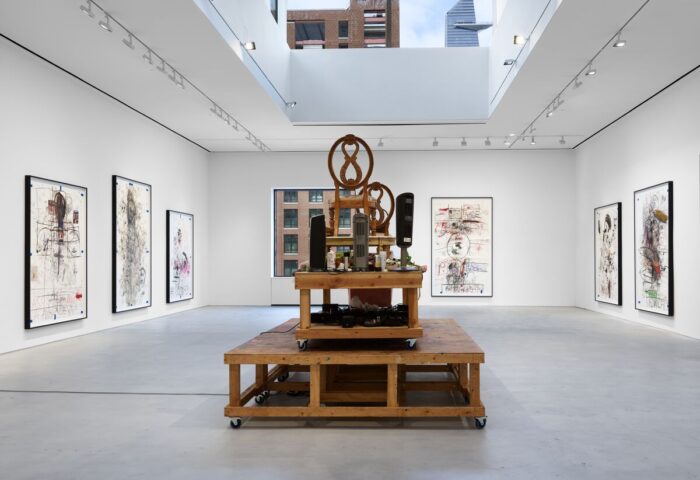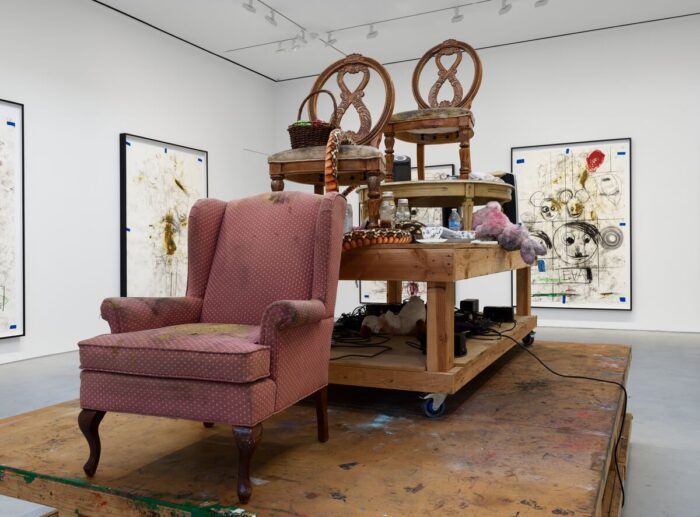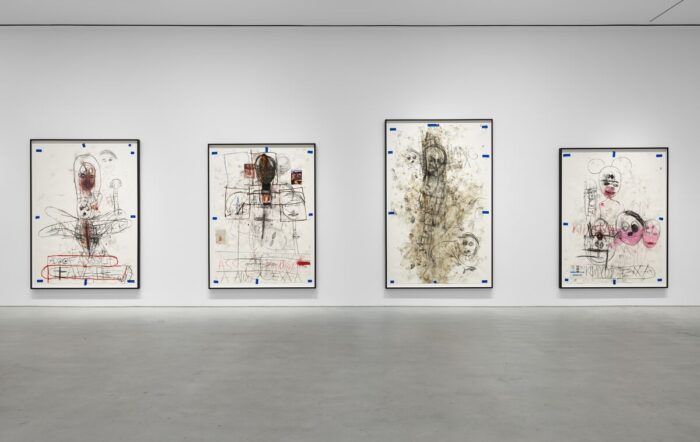







Paul McCarthy A&E Sessions – Drawing and Painting with Lilith Stangenberg at Hauser & Wirth, NYC
February 23 – April 10, 2021
Beginning 23 February, Hauser & Wirth will present new drawings, paintings, sculpture, and sound work by the celebrated American artist Paul McCarthy that confront the complex mechanisms of power, politics, desire, and history.
Central to the exhibition is a series of large-scale drawings from McCarthy’s most recent multi-disciplinary project ‘A&E.’ Created by the artist during improvised performances involving himself and German actor Lilith Stangenberg, these works serve as documentation of both McCarthy’s incisive critical lens and his practice of synthesizing performance, film, painting, drawing, sculpture, and sound.
i. On Paul McCarthy’s ‘A&E’ Series
‘Anyone who wants to hang a picture on the wall must first pound in a nail. To this end, one must knock.’ — Robert Walser, ‘Knocking’ (1923)
In 1966 and 1967 while still a student at the University of Utah in Salt Lake City, the city of his birth, Paul McCarthy began making large paintings on wooden door panels. He painted them flat on the ground and would climb on top of them. He drew on the panels and painted them not with a brush but with a rag, using black paint. He then pounded on them, beating them with a hammer or a board, effacing the surface. In the end, he poured gasoline on the paintings and threw a match on them, burning the panels black, making flayed wreckage that looked as if it had been transposed from the war then raging in Vietnam. In 1969, all but three of these works, which came to be known as McCarthy’s ‘black paintings,’ were fully burned and buried.
These black paintings united, from the very beginning of his life as an artist, two of McCarthy’s interdependent and inextricable interests: performance and object making – action painting in a sense, but action much more like performance than Jackson Pollock or Franz Kline would have conceived. The works were instead closer to the Anthropométrie paintings that Yves Kline had begun in France at the beginning of the decade and to the earlier paintings of the Gutai group in Japan, with which McCarthy had become acquainted through Allan Kaprow’s 1966 seminal book Assemblage, Environments, and Happenings. ‘At that time,’ McCarthy says, ‘I was aware of the Gutai artists, but I thought of what I was doing as making a painting as a doorway.’
In the five-plus decades since his black paintings, McCarthy has continued to combine performance and mark- making with an additional complimentary element – documentation of the performances and the pieces derived from them, a process that has become more obsessive and more extensive with each production, yielding a massive accumulation of video recordings, audio recordings, and still photographs.
In 1970, McCarthy began performing as a character, a persona, a practice that continues to this day. Dressing as ‘the other’ – a woman, George Bush, an animal, a sea captain, a grandfather, a pirate, Walt Disney, Ronald Reagan, Donald Trump, Hitler. In 1991, the performances began to take place within constructed architecture, specifically theatrical sets, and would use multiple video cameras. These works became closer in production to television and feature films, combining, feeding on, and fusing the three other pursuits into a kind of obverse- perverse Hollywood gesamtkunstwerk.
Two years ago McCarthy’s studio, in collaboration with McCarthy’s son, Damon, shot NV Night Vater, a project reminiscent of Night Porter, the 1974 Liliana Cavani film about a sadomasochistic relationship between a former Nazi concentration camp guard and his victim. In Night Vater, shot over a 30-day period, McCarthy plays a character named Max, an aging Hollywood producer obsessed with fascism and control. Lilith Stangenberg plays a young actress from Berlin who comes to Los Angeles to audition for a film being made by Max. The plot provided a skeletal structure for McCarthy and Stangenberg to enter through performance into a realm of psychological exclusion and masochism. At the conclusion of shooting, McCarthy and Stangenberg made a decision to go further into the subject and to film in nature, in a forest.
‘We thought, ‘Why don’t we go straight to the quintessential characters of Adolf Hitler and Eva Braun?’’ McCarthy says. ‘I began working on the script for this piece, which we decided to call A&E in 2019. Often what I do as an artist is a regurgitation of a vile substance, the black in the bottom of the glass. The title A&E is an abbreviation of Adolf and Eva and also of Adam and Eve, two cultural cliché polarities. A&E can also stand for ‘arts and entertainment.’ All three references function as human cultural signifiers. We were going to start production on A&E in August of 2020, and we now hope to shoot the film in summer 2021.’
‘A&E Sessions Drawing and Painting,’ the work on view in McCarthy’s new exhibition at Hauser & Wirth, is the result of two marathon sessions of drawing, painting and performance by McCarthy and Stangenberg – McCarthy as Adolf/Adam and Stangenberg as Eva/Eve. The first session, in 2019, took place outdoors in the lower Sierra mountains north of Los Angeles. The second session, in March 2020, occurred in the McCarthy Studio, the former studio of Jason Rhoades and Rachel Khedoori in Los Angeles.
‘I think of the A&E sessions as spinoffs looking toward the future, toward an A&E video series or feature project,’ McCarthy says. ‘The drawing and painting sessions are part of a trajectory in my work going back to the 60s, of drawing and painting as action or performance. In the drawing/painting sessions of A&E, we were ‘going into’ a realm, a world as both ourselves and as characters. The drawings were made on a big platform, a table that acted as the place, the location, a stage pedestal. Our actions were mashed together, entangled. Lilith was free to do as she wanted. I went in and out of drawing. The drawings came out of the arena we entered, ‘the other world.’’
McCarthy’s recursive performance-in-character-drawing as an intentional method dates back as far as 1981, when he performed as a sea captain in Death Ship at the Artemisia Gallery in Chicago and again in 1982, when he created five large-scale drawings at the Exile Gallery in Los Angeles based on small drawings from a 1975 performance and video, Sailor’s Meat, Sailor’s Delight. During the 1982 re-drawing sessions on the gallery floor, McCarthy recalls, ‘I was talking constantly as I was drawing – it was an action. I was by myself. The drawing action went on for several days.’
Two years later, in the character of a shambolic procreating infant, he continued the process with Baby World, creating a massively scaled drawing, again on the floor, at the Edge Gallery in Fullerton, California, a progression of meshing genres that continued and broadened for many years, through the major multidisciplinary works The Pirate Project in 2001 and White Snow in 2013. ‘I did drawings for those two projects in the studio on a big table, getting on the table on top of the drawings and drawing, constantly talking and gesturing,’ McCarthy says. ‘During the making of the series of drawings for Caribbean Pirates, I’m in the form of an imaginary pirate, Paul the pirate. In the series of drawings for White Snow I’m Walt Disney, or Walt Paul. But it is tricky to talk about. I’m not interested in trying to be an accurate representation of Walt Disney or a pirate. I’m adopting some form of the character. It is a process, a way of canceling out aspects of myself and finding new ones while drawing. Possibly at the core of it is the processing of images within sub-desire. You could say it’s a way of blocking out ‘Paul’s’ rational critical thought.” [As the philosopher Gilles Deleuze, whose thinking has been pivotal in McCarthy’s work, wrote: ‘It is not the slumber of reason that engenders monsters but vigilant and insomniac rationality.’]
The often-collaborative nature of such works can be traced back even earlier in McCarthy’s development, to his time at the San Francisco Art Institute, where he earned a bachelor’s degree in painting in 1969 after leaving Utah. ‘San Francisco was a political environment – the forming of collectives, groups, communes, the questioning of hierarchy and patriarchy and the belief in art as life were all part of the time; it was part of my foundation.’
‘There always seems to be a looping, a circling back into the subject again and again,’ McCarthy says of all the work he has done since those days. ‘There are drawings I’ve made now from the photographs and video recordings of the A&E drawing sessions that Lilith and I did.’ Performance intertwined with drawing and painting, then further intertwined with documentation and filmmaking that leads back to drawing and painting, forms an obsessive mis-en-abyme layering of work that becomes performative in itself. ‘In the 70s there might have been a few dozen images and one or two half-hour or hour-long videos of a performance. Now there can be more than 150,000 images of one project and terabytes of video recordings. It’s like I’m piling imagery on top of imagery. It’s accumulation on top of accumulation. Most of it will never be seen. It’s a wormhole. A pleasure tunnel with no light at the end.’
ii. A&E SESSION
Lilith as Eva as Eve as Lilith is on the platform world view. Paul as Adolf as Adam as Paul is on the platform kitchen table. The platform is a pedestal stage nest. The actions as pretend are a gateway to imagination and creative desire. The bodies’ actions, of the other. They are images of the self not for everyone. The actions are to affect the drawings. The action makes the drawings, the pretend as distraction. Lilith Eva Eve is free to do as she likes. Paul Adolf Adam is free to do as he likes. Lilith’s Eva’s Eve’s actions affect the drawings. She lies down on the drawing, scoots herself towards Adolf Adam Paul. Paul Adolf Adam continues the drawing, stops, continues. Eva’s Eve’s Lilith’s actions affect Adolf’s Adam’s Paul’s awareness, thoughts and actions. Lilith’s Eva’s action affect Lilith Eva Eve. Paul’s Adolf’s Adam’s actions affect Lilith’s Eva’s Eve’s awareness thoughts and actions. The drawings appear as the sole purpose and the ultimate output of the project, but the drawings are, in the end, only a part of the puzzle, which is a continuing downward labyrinth through the action, the performance.
—Paul McCarthy, 2020.
iii. DE PROFUNDIS
into it
So interesting
A&E
Deep diving
Blood and mud
And moon light and trees
And Adolf and Eva keep talking
She is chewing
She is the knife which stabs and the wound
The slap on the face and the cheek
The victim and the executioner
Her voice sometimes is the voice of the demon
All they want all they are is naked/empty/blackness
They eat each other’s hearts
He says Eva you want to grow old. You want to become old and weak and lonely and ugly? You should better die young and pretty!
—Lilith Stangenberg, 2020


